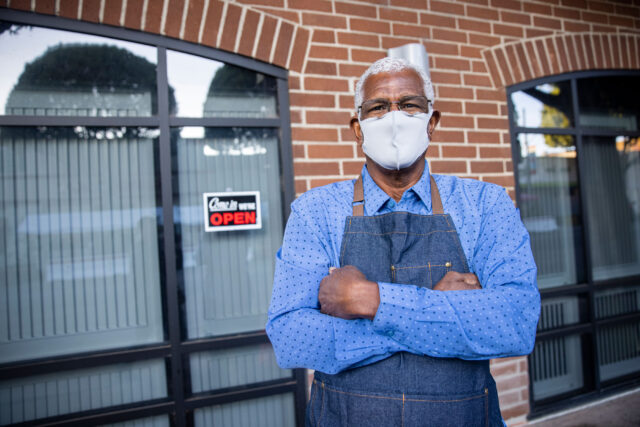Mark Baldassare, PPIC president and CEO, prepared these comments for the virtual briefing on the PPIC Statewide Survey: Californians and their Economic Well-Being on November 18, 2021.
The COVID-19 pandemic has disrupted the workplace since lockdowns sent many Californians home to work remotely in March 2020. A “next normal” of variety and flexibility has now taken root and will continue into 2022. After more than 18 months of pandemic conditions, how are Californians working today—and how do they want to work in the year ahead?
Employed Californians currently fall into three substantial groups according to the November PPIC survey. Notably, a solid majority (61%) work outside the home/at their place of work. In contrast, 22% work from home/remotely, and 15% have a mix of working remotely and working outside the home.
If given the choice next year, a plurality (42%) say their preference is to work full time outside the home/at their workplace, 24% say they would like to work full time from home/remotely, and 33% would like to have a mix.
If employed Californians have their way in 2022—and they will have leverage in a tight labor market—employers and fellow workers will need to adjust. First, there is a growing desire for a hybrid mix. Second, fewer would like to go to the workplace. At the same time, interest in working remotely has hit a ceiling.
The fundamentals of work location and home life have changed quickly and dramatically. Remarkably, 73% of those working remotely some or all of the time today say they started this practice as a result of the pandemic lockdowns. Moreover, nearly half of Californians (49%)—including workers and the unemployed—say that they or someone else in their household worked from home in the past year.
Today, workplace situations vary widely across regions and demographic groups—and may influence job satisfaction. Preferences for next year are also quite variable.
Regions. Employed Californians living in the inland regions of the state are much more likely to work outside the home (79% Inland Empire, 75% Central Valley) than those living in the South Coast region (59% Los Angeles, 59% Orange/San Diego) or, especially, in the San Francisco Bay Area (47%).
Looking toward 2022, the patterns are the same: the preference for working outside of the home is much more common in the inland regions (57% Central Valley, 53% Inland Empire) than in the South Coast region (46% Los Angeles, 38% Orange/San Diego) or, again, in the San Francisco Bay Area (26%).
Demographics. The likelihood of working outside of the home increases with age (56% ages 18 to 34; 60% ages 35 to 54; 70% ages 55 and older) and declines sharply with college education and higher income. It varies across racial/ethnic groups (76% Latinos, 61% African Americans, 53% whites, 48% Asian Americans).
The preference for working outside of the home next year increases with age (38% ages 18 to 34; 42% ages 35 to 54; 48% ages 55 and older). It declines sharply with college education and higher income, while varying across racial/ethnic groups (60% Latinos, 32% whites, 31% Asian Americans, 30% African Americans).
Interestingly, there is much in common among men and women, between homeowners and renters, and among those living in households with children and without children when it comes to who is currently working outside the home and who would like to work outside of the home in 2022.
Job satisfaction. Today, those working outside the home are slightly less likely than others to say that they are “very satisfied” with their job (35% working outside the home, 40% mix, 42% working remotely). But those who prefer to work outside the home next year are the most likely to report that they are “very satisfied” with their job (44% work outside the home, 33% mix, 31% work remotely).
What about remote work and financial well-being? The proportion who say they are “not satisfied” with their household’s financial situation is similar across current workplace locations (21% working outside the home, 21% mix, 20% working remotely). Financial dissatisfaction is highest among those who prefer to work remotely next year (28% work remotely, 22% mix, 17% work outside the home).
The impact of workplace alterations on California’s economy and quality of life could be far reaching. What will the future hold for office buildings and retail spaces in central business districts? What can local governments anticipate in terms of sales tax revenues? How will public buses and commuter rail systems respond to the variety and flexibility of work locations? What are the impacts on housing choices within regions—and migration within and outside the state?
The November PPIC survey found that about two thirds of employed Californians said their current type of workplace was also their preferred type of workplace in 2022. With a majority in our poll saying inequality is getting worse in California, and since not everyone is able to choose where they work, the broader social and economic implications of these workplace trends will be highly significant. The degree to which employed Californians are able to align their workplace preferences with their current employment—and what happens when there is a mismatch—is of ongoing interest for 2022 and beyond. The future (of work) is now!




